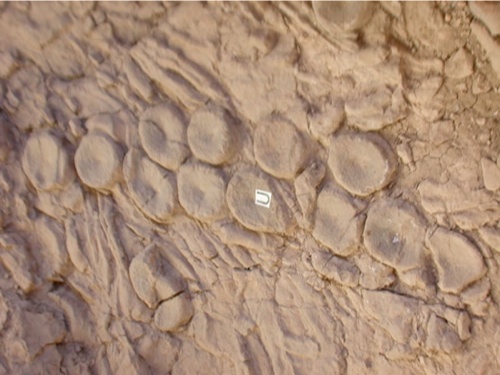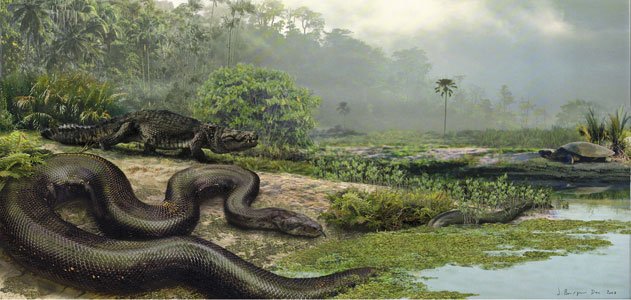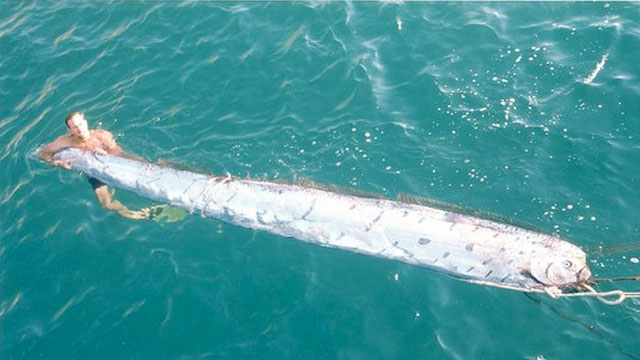https://ift.tt/1popg36
Our ancestors relied on the supernatural to explain certain phenomenon. Ancient civilizations that saw strange things would try to explain them by associating them with the gods or monsters. This resulted in the creation of various myths which, as you’ll soon discover, have a bit of truth to them. They became myths thanks to exaggeration on the part of eyewitnesses or storytellers, but on some level they actually existed.
10. Giant Triassic Cephalopod – Kraken
Krakens are legendary sea monsters believed to be capable of devouring ships and whales. Fossils discovered by a paleontologist named Mark McMenamin and his team suggest that the legendary kraken might not be entirely mythical, as a giant Triassic cephalopod similar to how this legendary being looked and behaved might have existed millions of years ago.
It all started when McMenamin and his team presented an unusual “arrangement of vertebrae of the ichthyosaur Shonisaurus popularis” to the Geological Society of America in 2011. The bones were found by McMenamin in the Berlin-Ichtyosaur State Park in Nevada. The Shonisaurus was a marine reptile that lived about 200 to 250 million years ago during the Triassic period, and it’s the same size as a modern bus. When McMenamin and his team unearthed the bones, they noticed that they were arranged in a “strange linear pattern.” They theorized that the bones were arranged by an intelligent giant cephalopod, rationalizing that modern day octopuses “play” with their food in the form of creating middens from the shells and bones of their prey. McMenamin argues that this giant cephalopod was none other than the legendary kraken.
Furthermore, McMenamin later unearthed a fossil that might have been part of the beak of a giant Triassic cephalopod. This discovery further strengthened his theory, although not all paleontologists agree with McMenamin. David Fastovsky, a paleontologist at the University of Rhode Island, said, “A kraken isn’t really necessary. Everything can be explained by much less exotic means.”
9. Okapi – Unicorn
Also, known as the African Unicorn, the Okapi is a doe-eyed animal that’s a close relative of the giraffe. Its most distinct features are the zebra-like stripes it has on its rear and legs. The male okapi has two horns, but when viewed from the side it can look like one horn. This led explorers from the Victorian era to believe that they had found the legendary unicorn.
The myth that the Okapi was the unicorn proliferated due to the fact that this animal is very shy and usually moves around only with another Okapi. Sightings were rare, making it difficult for European explorers to study this animal and find out what it truly is. The myth and mystery surrounding the African Unicorn were finally dispelled during the 1900s thanks to Sir Harry Johnston. He was an animal collector, botanist, linguist and colonial administrator in Africa. He was able to acquire two skulls and a complete skin of the Okapi. He sent the samples to London where it was found out that the Okapi, much to the dismay of countless young girls, was not the legendary unicorn but a “forest-dwelling relative of the giraffe.”
8. Megalania – Dragon
Dragons have fascinated mankind for thousands of years. There’s something magical about these mythical creatures that just catches our interest, and evidence suggests that dragons almost as fierce as the ones depicted in myths once existed. No, we’re not talking about Komodo Dragons. We’re talking about creatures that are far more powerful, deadly and gigantic — the Megalania.
The Megalania may not have wings or breathe fire, but it sure was the king of its time. It was an apex predator during the Pleistocene epoch. Its most distinguishing features were its splayed legs and powerful jaws. Scientists believe that the Megalania may have measured somewhere between 12 and 25 feet and weighed anywhere between 500 and 4,000 pounds! The Komodo Dragon, which is considered to be largest living lizard, is nothing compared to the size and power of this beast.
7. Titanoboa – Imoogi
The Imoogi is a dragon-like creature from Korean mythology. Its features were like that of a python, and it lived in caves or water. There are two accounts explaining what the Imoogi is. One account says that the Imoogi, being a dragon-like creature, was cursed and could not become a true dragon. The other account says that the Imoogi was a “proto-dragon,” meaning it had to live one millennium before it could become a genuine dragon.
Several years ago, scientists discovered fossils of a giant snake that resembled the Imoogi. This “prehistoric monster snake” is called the Titanoboa. It lived 58 million years ago. The Titanoboa was gigantic, measuring at approximately 50 feet and weighing more than a ton. It was so big it could swallow large reptiles like crocodiles without “showing a bulge”! Being a distant relative of the boa constrictor and the anaconda, the Titanoboa was not venomous. It killed its prey by crushing them with its amazing constricting force.
6. Vlad Tepes – Count Dracula
We all know who Count Dracula is, but how many of us know about Vlad Tepes, the historical leader that inspired Bram Stoker to create his famous vampire character? Tepes was a Romanian prince who lived during the 15th century. He was a cruel and inhuman leader who, just like Count Dracula, had a great liking towards blood. Unlike Count Dracula, Tepes didn’t need blood to stay alive, but one historical account does state that he drank his victims’ blood anyway.
What’s more horrifying is that Tepes would usually dine with his victims before murdering them. It’s estimated that he killed 40,000 people, many of which were tortured for hours or even days. Tepes killed his victims in various ways but his favorite, and the one he’s famous for, is impaling. With this method, an oiled spike was inserted into the “victim’s anus and pushed in until the other end emerged from the victim’s mouth.”
5. Giant Oarfish – Sea Serpent
Sea serpents are mythical creatures that look like gigantic snakes. This legendary being has both terrified and fascinated people for hundreds of years. The discovery of an enormous marine creature in Santa Catalina Island off the coast of Southern California proved that sea serpents do exist, although they’re not scary monsters — simply fish. To be more specific, they’re giant oarfish.
In 2013, a giant oarfish was discovered by a marine science instructor named Jasmine Santana while snorkeling in Santa Catalina Island. It was so big that she needed the help of 15 people to drag it to shore. Unfortunately, it was already dead when Santana found it. It was 18 feet long, and it’s believed that oarfish can grow to be as much as 50 feet. Giant oarfish are rarely seen on the surface since they usually dive more than 3,000 feet deep, and so little is known about them. Since sightings of this gigantic creature are rare and because it’s enormous and snake-like, the oarfish has been dubbed scary and magical.
4. Flamingos – Phoenix
The phoenix is a mythical bird that’s believed to be immortal and has healing powers it can bestow to people. This legendary being is prominent in Chinese and Egyptian mythologies. In the former it’s called Fenghuang, while in the latter it’s Bennu. According to myth, the phoenix would engulf itself in fire but instead of dying a young phoenix would emerge. The phoenix has therefore become a symbol of rebirth or transformation.
Many experts believe that the origin of the mythical phoenix might have come from a beautiful bird found in Africa — the flamingo. Of course, the flamingo isn’t immortal and it sure isn’t capable of engulfing itself in fire. However, a certain behavior displayed by it is identical to one prominent characteristic of the phoenix, leading experts to believe that this bird is the origin of the myth.
Flamingos usually build their nests on salt flats. Even though the temperature of these salt flats is high, mature flamingos can survive them. However, when female flamingos give birth they need to build tall mounds since young chicks can’t survive the heat. The nest located on top of the mounds is where the flamingo lay its eggs. When seen from afar, “the haze of heat that surrounds” the flamingo’s nest resemble the haze that we usually see around fire. This phenomenon might have led people to believe that the flamingo can engulf itself on fire, giving birth to the myth of the phoenix.
3. Dwarf Elephants – Cyclops
According to Greek mythology, Cyclopes are a giant race of people with one gigantic eye in the middle of their foreheads. They are believed to have inhabited the island of Sicily. The most famous account about them can be found in Homer’s Odyssey, where Odysseus encounters a Cyclops named Polyphemus and later escapes from him.
There’s a reason Sicily was called the land of the Cyclopes — numerous remains of a mysterious creature can be found there. Ancient Greeks who saw the mysterious remains couldn’t figure out what kind of animal would have a big hole in the middle of its forehead. They relied on the supernatural in order for them to make sense of the mysterious remains, and this resulted in the birth of the Cyclopes myth.
However, science tells us that the bones found in Sicily belong to a certain animal species called dwarf elephants. They lived during the Ice Age, and the gigantic holes found in the middle of their foreheads are their nostrils. Their eye sockets are located “deep down on the sides” of their skulls.
2. Protoceratops – Griffin
Griffins are legendary beings from Greek mythology. They guard treasures of gold and bear the head of an eagle and the body of a lion. In the 1900s it was proven that this mythical creature did once roam the Earth, but it had no wings and it certainly wasn’t a hybrid animal.
The Gobi Desert of Mongolia was once home to the protoceratops. More than two thousand years ago, the Gobi Desert was mined for its gold by a group of people called the Scythians. As they were mining, they found numerous fossils of the protoceratops. As paleontology wasn’t yet established they turned to the supernatural to explain this dinosaur, and that resulted in the birth of the legendary griffin.
1. Gigantopithecus – Bigfoot
Also known as Sasquatch, Bigfoot is a popular mythical creature believed to inhabit the forests of the Pacific Northwest. It’s a cryptid believers think is covered in dark reddish or dark brown hair and weighs around 500 pounds. This legendary being is also believed to be somewhere between six to 10 feet tall.
Many people regard Bigfoot as nothing more than a figment of our imagination. However, a certain creature that existed thousands of years ago in South Asia might be the real Sasquatch that Bigfoot enthusiasts are searching for. This creature, called the Gigantopithecus, unfortunately went extinct 300,000 years ago. Just like Bigfoot, the Gigantopithecus was gigantic. It weighed approximately 1,200 pounds and achieved a staggering height of 10 feet. Experts learned about the existence of the Gigantopithecus in 1935, thanks to a German paleoanthropologist named Ralph von Koenigswald. He was in Hong Kong and out of mere luck he saw a big primate molar at a pharmacy. Since then, hundreds of this creature’s remains have been unearthed in India, China and Vietnam.
Want to read about more myths?
AMAZING
TRENDS,AMAZING
via Toptenz.net http://www.toptenz.net
May 14, 2018 at 06:32AM
.png)











No comments:
Post a Comment